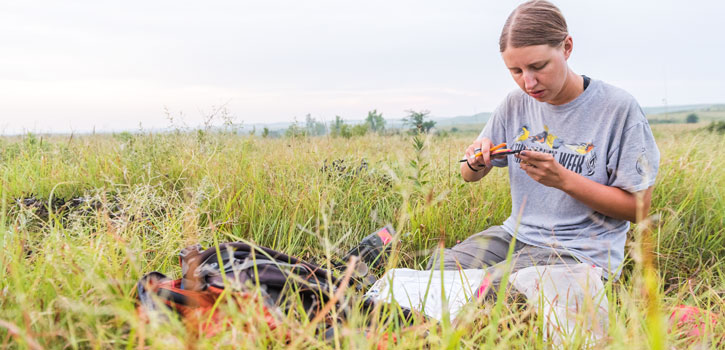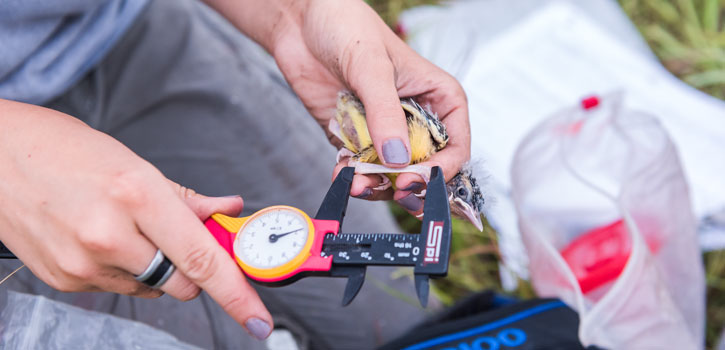Taking research to the nest level: Prairie songbird biologist engages public in her work on nestlings
By Beth Bohn

Seek more
Sarah Winnicki is passionate about sharing her prairie songbird research. Watch videos, look at photos and learn more about her work.
Website: sarahwinnicki.com
Twitter: @skwinnicki
YouTube channel: bit.ly/2PRRRfc
Learn more about the Kansas Science Communication Initiative and the Sunset Zoo’s Science Communication Fellowship program.
Finding and tracking the growth and development of songbird nestlings is how Sarah Winnicki feathers her research nest, and getting to tweet about her work makes this prairie songbird biologist as happy as a lark, or at least a grasshopper sparrow.
Winnicki is a master’s student in ornithology at Kansas State University where she is a member of the lab of Alice Boyle, assistant professor of bird ecology. Learn more about Boyle’s work.
The team is studying grassland birds at the Konza Prairie Biological Station, a tallgrass prairie reserve jointly operated by the university and The Nature Conservancy. The team searches for nestlings and then tracks them using transmitters and tags to monitor their growth and the predators the young birds face. Winnicki is using the work for her master’s thesis on cowbird parasitism and how it affects the growth and development of nestlings of three grassland species: grasshopper sparrow, dickcissel and eastern meadowlark. The cowbird is a bird that lays its eggs in other birds’ nests.
Winnicki has been a birder since her childhood in Ohio where she was involved with the Ohio Young Birders Club. She pairs her love of bird-watching with conservation and science communication efforts through her website, Twitter account and YouTube channel.
“I love my science, so sharing it seems very natural,” Winnicki said. “I had always shared photos of the birds I saw as I was out birding, so when I started working with birds professionally, transitioning to using social media to share my science was seamless.”
Winnicki calls her “adorable nestlings” the perfect excuse for sharing photos and videos of them, such as how nestlings eagerly leave their nests; how she and her fellow team members discover new nestlings; and even how nestlings sometimes escape, and sometimes do not escape, predators such as snakes.
“Social media like Twitter allow me to connect not only with other scientists interested in my work, but also with anyone interested in birds in general,” Winnicki said. “Because of my communication through social media, I have been able to connect with nonscientists, with professional scientists in other fields and with collaborators, all while having a ton of fun.”
Winnick credits two university-related programs with helping her enhance her science communication efforts. In 2016, she was accepted to the Sunset Zoo’s Science Communication Fellowship program for graduate students and postdoctoral researchers. The fellowship is part of the Manhattan zoo’s Behind the Science program that is funded by the National Science Foundation and an Institute of Museum and Library Services grant.
Winnicki also takes part in the Kansas Science Communication Initiative, which helps K-State faculty, students and staff engage the public in science and research.
“The training with the zoo’s fellowship program provided very insightful feedback about my science communication skills and techniques, such as pointing out when I was using jargon or when I was being too technical and how to connect my research to people,” Winnicki said. “The experience has been helpful not only for my public science communication but also for my teaching and for my professional science communication as well.”
Involvement in the Kansas Science Communication Initiative has helped Winnicki find a larger audience and hone her message for a broader group.
Winnicki was drawn to K-State while an undergraduate at Denison University in Ohio. The school did not offer an ornithology program, so she applied to Research Experience for Undergraduates, or REU, programs offering a bird research project. She was accepted to K-State’s program with Boyle’s lab in 2014 and 2015. She then joined Boyle’s lab as a master’s student.
After completing her master’s degree in 2019, Winnicki plans to seek her doctorate. Her goal is to land a faculty position teaching ornithology and animal behavior and to continue her research on songbird nestlings.

Sarah Winnicki takes measurements from a grasshopper sparrow on the Konza Prairie.
